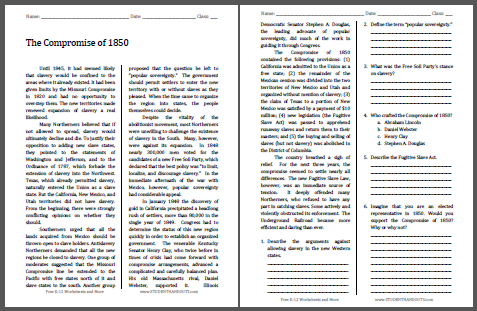The Compromise of 1850 |
Until 1845, it had seemed likely that slavery would be confined to the areas where it already existed. It had been given limits by the Missouri Compromise in 1820 and had no opportunity to overstep them. The new territories made renewed expansion of slavery a real likelihood. Many Northerners believed that if not allowed to spread, slavery would ultimately decline and die. To justify their opposition to adding new slave states, they pointed to the statements of Washington and Jefferson, and to the Ordinance of 1787, which forbade the extension of slavery into the Northwest. Texas, which already permitted slavery, naturally entered the Union as a slave state. But the California, New Mexico, and Utah territories did not have slavery. From the beginning, there were strongly conflicting opinions on whether they should. Many Northerners believed that if not allowed to spread, slavery would ultimately decline and die. To justify their opposition to adding new slave states, they pointed to the statements of Washington and Jefferson, and to the Ordinance of 1787, which forbade the extension of slavery into the Northwest. Texas, which already permitted slavery, naturally entered the Union as a slave state. But the California, New Mexico, and Utah territories did not have slavery. From the beginning, there were strongly conflicting opinions on whether they should.Southerners urged that all the lands acquired from Mexico should be thrown open to slave holders. Antislavery Northerners demanded that all the new regions be closed to slavery. One group of moderates suggested that the Missouri Compromise line be extended to the Pacific with free states north of it and slave states to the south. Another group proposed that the question be left to "popular sovereignty." The government should permit settlers to enter the new territory with or without slaves as they pleased. When the time came to organize the region into states, the people themselves could decide. Despite the vitality of the abolitionist movement, most Northerners were unwilling to challenge the existence of slavery in the South. Many, however, were against its expansion. In 1848 nearly 300,000 men voted for the candidates of a new Free Soil Party, which declared that the best policy was "to limit, localize, and discourage slavery." In the immediate aftermath of the war with Mexico, however, popular sovereignty had considerable appeal. In January 1848 the discovery of gold in California precipitated a headlong rush of settlers, more than 80,000 in the single year of 1849. Congress had to determine the status of this new region quickly in order to establish an organized government. The venerable Kentucky Senator Henry Clay, who twice before in times of crisis had come forward with compromise arrangements, advanced a complicated and carefully balanced plan. His old Massachusetts rival, Daniel Webster, supported it. Illinois Democratic Senator Stephen A. Douglas, the leading advocate of popular sovereignty, did much of the work in guiding it through Congress. The Compromise of 1850 contained the following provisions: (1) California was admitted to the Union as a free state; (2) the remainder of the Mexican cession was divided into the two territories of New Mexico and Utah and organized without mention of slavery; (3) the claim of Texas to a portion of New Mexico was satisfied by a payment of $10 million; (4) new legislation (the Fugitive Slave Act) was passed to apprehend runaway slaves and return them to their masters; and (5) the buying and selling of slaves (but not slavery) was abolished in the District of Columbia. The country breathed a sigh of relief. For the next three years, the compromise seemed to settle nearly all differences. The new Fugitive Slave Law, however, was an immediate source of tension. It deeply offended many Northerners, who refused to have any part in catching slaves. Some actively and violently obstructed its enforcement. The Underground Railroad became more efficient and daring than ever. |
Click here to print. Answer Key: (1) Missouri Compromise; statements of Washington and Jefferson; Ordinance of 1787; (2) the people in the territories themselves could decide whether or not their state would be free or slave; (3) "to limit, localize, and discourage slavery;" (4) C - Henry Clay; (5) part of the Compromise of 1850; passed to apprehend runaway slaves and return them to their masters. |
 |
|---|
Text courtesy of the U.S. State Department, Bureau of International Information Programs, 2005 |










